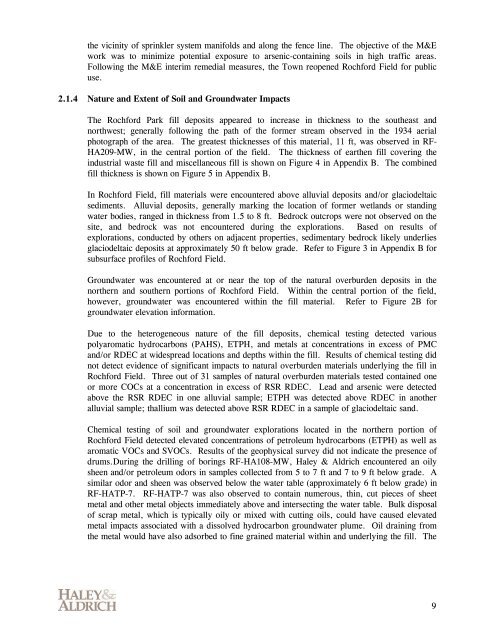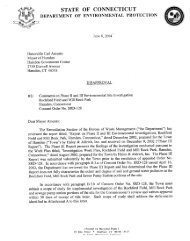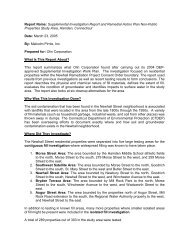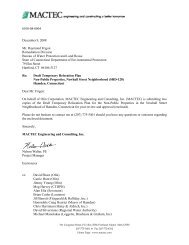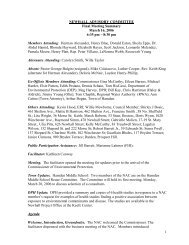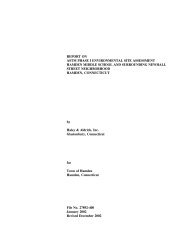Remedial Action Plan - Rochford Field - Newhall Remediation Project
Remedial Action Plan - Rochford Field - Newhall Remediation Project
Remedial Action Plan - Rochford Field - Newhall Remediation Project
You also want an ePaper? Increase the reach of your titles
YUMPU automatically turns print PDFs into web optimized ePapers that Google loves.
the vicinity of sprinkler system manifolds and along the fence line. The objective of the M&E<br />
work was to minimize potential exposure to arsenic-containing soils in high traffic areas.<br />
Following the M&E interim remedial measures, the Town reopened <strong>Rochford</strong> <strong>Field</strong> for public<br />
use.<br />
2.1.4 Nature and Extent of Soil and Groundwater Impacts<br />
The <strong>Rochford</strong> Park fill deposits appeared to increase in thickness to the southeast and<br />
northwest; generally following the path of the former stream observed in the 1934 aerial<br />
photograph of the area. The greatest thicknesses of this material, 11 ft, was observed in RF-<br />
HA209-MW, in the central portion of the field. The thickness of earthen fill covering the<br />
industrial waste fill and miscellaneous fill is shown on Figure 4 in Appendix B. The combined<br />
fill thickness is shown on Figure 5 in Appendix B.<br />
In <strong>Rochford</strong> <strong>Field</strong>, fill materials were encountered above alluvial deposits and/or glaciodeltaic<br />
sediments. Alluvial deposits, generally marking the location of former wetlands or standing<br />
water bodies, ranged in thickness from 1.5 to 8 ft. Bedrock outcrops were not observed on the<br />
site, and bedrock was not encountered during the explorations. Based on results of<br />
explorations, conducted by others on adjacent properties, sedimentary bedrock likely underlies<br />
glaciodeltaic deposits at approximately 50 ft below grade. Refer to Figure 3 in Appendix B for<br />
subsurface profiles of <strong>Rochford</strong> <strong>Field</strong>.<br />
Groundwater was encountered at or near the top of the natural overburden deposits in the<br />
northern and southern portions of <strong>Rochford</strong> <strong>Field</strong>. Within the central portion of the field,<br />
however, groundwater was encountered within the fill material. Refer to Figure 2B for<br />
groundwater elevation information.<br />
Due to the heterogeneous nature of the fill deposits, chemical testing detected various<br />
polyaromatic hydrocarbons (PAHS), ETPH, and metals at concentrations in excess of PMC<br />
and/or RDEC at widespread locations and depths within the fill. Results of chemical testing did<br />
not detect evidence of significant impacts to natural overburden materials underlying the fill in<br />
<strong>Rochford</strong> <strong>Field</strong>. Three out of 31 samples of natural overburden materials tested contained one<br />
or more COCs at a concentration in excess of RSR RDEC. Lead and arsenic were detected<br />
above the RSR RDEC in one alluvial sample; ETPH was detected above RDEC in another<br />
alluvial sample; thallium was detected above RSR RDEC in a sample of glaciodeltaic sand.<br />
Chemical testing of soil and groundwater explorations located in the northern portion of<br />
<strong>Rochford</strong> <strong>Field</strong> detected elevated concentrations of petroleum hydrocarbons (ETPH) as well as<br />
aromatic VOCs and SVOCs. Results of the geophysical survey did not indicate the presence of<br />
drums.During the drilling of borings RF-HA108-MW, Haley & Aldrich encountered an oily<br />
sheen and/or petroleum odors in samples collected from 5 to 7 ft and 7 to 9 ft below grade. A<br />
similar odor and sheen was observed below the water table (approximately 6 ft below grade) in<br />
RF-HATP-7. RF-HATP-7 was also observed to contain numerous, thin, cut pieces of sheet<br />
metal and other metal objects immediately above and intersecting the water table. Bulk disposal<br />
of scrap metal, which is typically oily or mixed with cutting oils, could have caused elevated<br />
metal impacts associated with a dissolved hydrocarbon groundwater plume. Oil draining from<br />
the metal would have also adsorbed to fine grained material within and underlying the fill. The<br />
9


